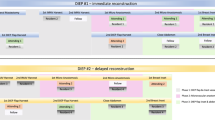Abstract
Introduction
The trapezius muscle is a good option for soft tissue defects in the cervical and thoracic regions. However, pedicled flaps raised from perforators in the trapezius are rare. Through a series of cadaver dissections, the authors aim to map the perforating arteries in the trapezius muscle.
Materials and methods
Dissection of 58 anatomical regions in 32 cadavers was carried out. The perforating arteries of the trapezius were inventoried based on their location, dimensions and frequency using the scapular spine and spinous process line as landmarks.
Results
In 78% of cases, the main perforators of the trapezius were located along two vertical lines parallel to the spinous process line, 5–6 cm on either side of it, between the scapular spine laterally, the tip of the scapula caudally and the superior margin of the trapezius cranially. On each side of the spinous process line, we found an average of 16 perforators (range 5–27) with an average diameter of 0.6 mm (range 0.1–2.6 mm).
Conclusion
Our study shows that surgeons can use fixed landmarks when developing trapezius perforator flaps.





Similar content being viewed by others
References
Angrigiani C, Grilli D, Karanas YL, Longaker MT, Sharma S (2003) The dorsal scapular island flap: an alternative for head, neck, and chest reconstruction. Plast Reconstr Surg 111(1):67–78
Baek SM, Biller HF, Krespi YP, Lawson W (1980) The lower trapezius island myocutaneous flap. Ann Plast Surg 5(2):108–114
Blondeel PN, Morris SF, Hallock GG, Neligan PC (2013) Perforator flaps: anatomy, technique, clinical applications. CRC Press, Boca Raton
Boucher F, Mojallal A (2015) Atlas des artères perforantes de la peau, du tronc et des membres. Elsevier Masson, Paris
Haas F, Weiglein A, Schwarzl F, Scharnagl E (2004) The lower trapezius musculocutaneous flap from pedicled to free flap: anatomical basis and clinical applications based on the dorsal scapular artery. Plast Reconstr Surg 113(6):1580–1590
Hafezi F, Naghibzadeh B, Pegahmehr M, Boddouhi N, Nouhi A (2008) Extended vertical trapezius fasciocutaneous flap (back flap) in face and neck burn scar reconstruction. Ann Plast Surg 61(4):441–446
Hamdi M, Stillaert FB (2010) Pedicled perforator flaps in the trunk. Clin Plast Surg 37(4):655–665
Ikka L, Mihalea C, Achour NB, Khalek HA, Vacher C (2016) The origin of the dorsal scapular artery: anatomic variations and surgical applications. Surg Radiol Anat 38(9):1–7
Lynch JR, Hansen JE, Chaffoo R, Seyfer AE (2002) The lower trapezius musculocutaneous flap revisited: versatile coverage for complicated wounds to the posterior cervical and occipital regions based on the deep branch of the transverse cervical artery. Plast Reconstr Surg 109(2):444–450
Maruyama Y, Nakajima H, Fujino T, Koda E (1981) The definition of cutaneous vascular territories over the back using selective angiography and the intra-arterial injection of prostaglandin E1: some observations on the use of the lower trapezius myocutaneous flap. Brit J Plast Surg 34(2):157–161
Mathes SJ, Nahai F (1981) Classification of the vascular anatomy of muscles: experimental and clinical correlation. Plast Reconstr Surg 67(2):177–187
Morris SF, Tang M, Almutari K, Geddes C, Yang D (2010) The anatomic basis of perforator flaps. Clin Plast Surg 37(4):553–570
Rozen WM, Fox CM, Leong J, Morsi A (2013) The “Chimeric” trapezius muscle and fasciocutaneous flap (dorsal scapular artery perforator flap): a new design for complex 3-dimensional defects. Annals of plastic surgery 71(5):528–532
Sadigh PL, Chang LR, Hsieh CH, Feng WJ, Jeng SF (2014) The trapezius perforator flap: An underused but versatile option in the reconstruction of local and distant soft-tissue defects. Plast Reconstr Surg 134(3):449e-56e
Salmon M, Grégoire R (1936) Artères de la peau, vol 4. Masson, Paris, pp 123–131
Salmon M, Dor J (1933) Les artères des muscles des membres et du tronc. Masson, Paris
Weiglein AH, Haas F, Pierer G (1996) Anatomic basis of the lower trapezius musculocutaneous flap. Surg Radiol Anat 18(4):257–261
Acknowledgements
The authors are grateful for the contribution of the entire staff of the Lille University Anatomy Laboratory (France) to this work, along with the staff of the Radiology Department of the Lille University Hospital.
Author information
Authors and Affiliations
Corresponding author
Rights and permissions
About this article
Cite this article
Manyacka Ma Nyemb, P., Fontaine, C., Martinot-Duquennoy, V. et al. Trapezius perforator flaps: anatomical basis using 58 dissections. Surg Radiol Anat 40, 903–910 (2018). https://doi.org/10.1007/s00276-018-2044-y
Received:
Accepted:
Published:
Issue Date:
DOI: https://doi.org/10.1007/s00276-018-2044-y




